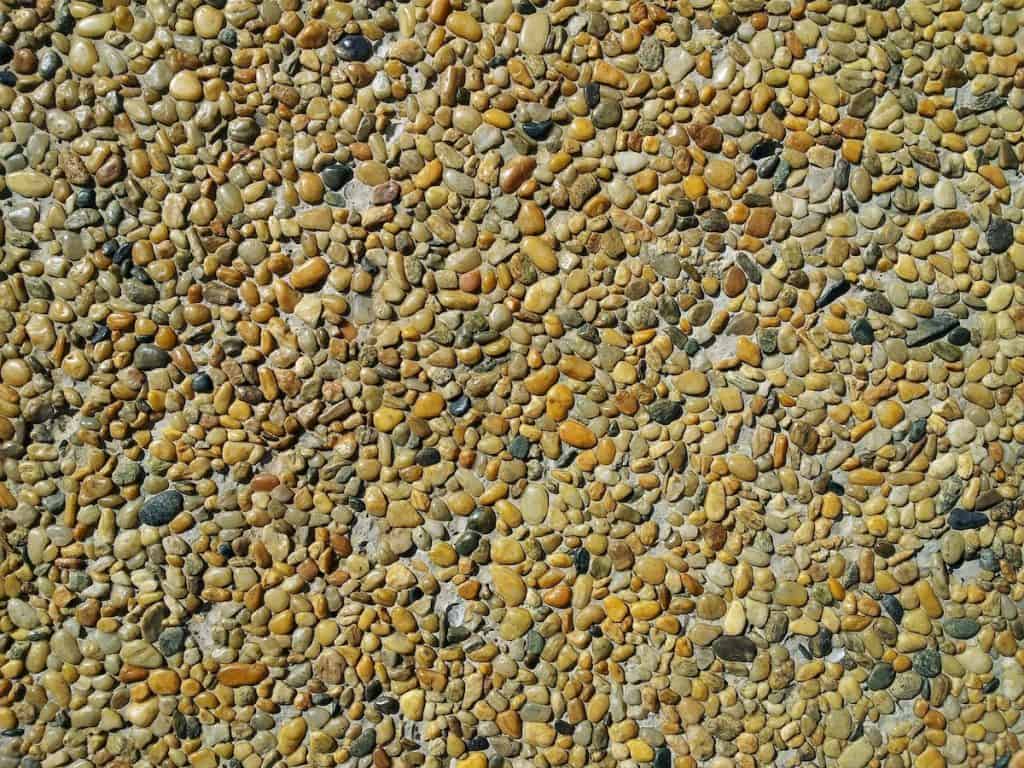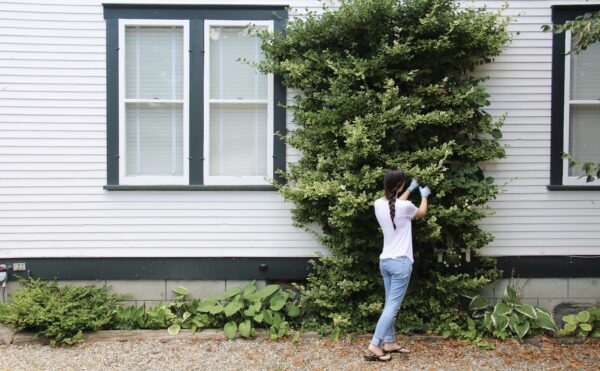Decorative gravel is any type of small ornamental rocks or rock fragments used in exterior decor or landscaping. Most landscaping uses for decorative gravel are surface coverings, including rock mulch, driveways, and pathways. Types of decorative gravel include pea gravel, crushed rock, and river pebbles.
1. Decorative gravel paths and walkways
Decorative gravel is perfect for garden paths and backyard walkways. This permeable, low-maintenance surface material has a classic traditional appeal and is an eco-friendly choice. Both crushed rock and pea gravel are used to create walkway surfaces.
You can connect a garden to a small tree or bench with a trail of river stones. These pathways stand out and provide a helpful path if you’re trying to avoid stepping on the grass. Paths of decorative gravel can also lead the eye and serve as part of the foundational design of the garden.
If you have a fire pit in the backyard, create a pathway of rocks from the house to the pit. The rocks provide a beautiful aesthetic to complete your backyard patio entertaining area.

2. Landscaped gravel driveway
A decorative gravel driveway is a nice way to bring the natural stone to a large surface. Gravel driveways are generally low-cost to install. They also reduce the number of paved surfaces, which helps to allow rainwater into the soil. Permeable driveways support the local soil ecosystem while lessening the load on city storm sewer systems.
Delivery of bulk gravel is generally done with a dump truck or with smaller loads in a dumper trailer. Shoveling gravel is hard work, but there are many landscaping companies that have experience building decorative gravel driveways.

3. Decorative gravel for potted plants
Decorative gravel is perfect for planting pots or container gardens on the patio. Use it as mulch by placing a thin layer of rocks on top of the soil. This makes the plant stand out and also protects the potting soil from erosion. The rocks can also help hold in heat in the summertime after the sun goes down.
A bag of decorative gravel can cost between $1 for a small bag at the dollar store, $10 for a medium-sized bag at the hardware store, to $20 for a bucket at a landscaping supplier. There are many different colors and textures available. Take the time to find the perfect complement for your container plant!
4. Ornamental gravel landscaping mulch for succulents & drought-tolerant plants
Do you have a small garden that helps make the front of your house look inviting? If it basks in the sun, it might be a great spot for ornamental gravel mulch covering the soil surface. Some areas of your property just need a little filler to improve the look or break up certain parts of the yard.
Replace the organic mulch or grass with decorative gravel and a xeriscaped garden bed. It won’t absorb any of the water, and it will allow any moisture to go straight to the soil. Here are some drought-tolerant perennial flower plants that work well in dry, sunny spots.

5. Fire pit surrounds
Some in-ground fire pit surrounds are specifically designed for a decorative gravel surround. The spaces between the pieces of gravel allow for airflow for pits that have below-ground air exchange vents. Decorative gravel also withstands the heat given off from the fire pit better than grass growing right up to the outside.
Choose rocks that work with the design of your fire pit, both practically and aesthetically. For the pit above, we chose rounded natural stones from the same local quarry. Decorative rocks are generally screened out in size brackets, such as 1″-3″ rock, 3″+ rock, or larger cobbles. We used large pebbles around the outside and larger matching cobbles inside the pit.
6. Boundaries and edges of gardens, paths, & structures
For thousands of years, humans have used rocks to form walls, define edges, and mark boundaries. The same principle works for modern homes, too!
Your garden beds, property line, and home can be lined with decorative rocks for a classic look. Larger pebbles tend to be fine defining an edge on their own, while smaller pebbles may benefit from being contained by an edging material.


7. Decorative gravel patio
Gravel patios have been a mainstay of garden design for centuries! And there’s a good reason why. They’re gorgeous, low-maintenance, and suited to various different styles of architecture.
A gravel patio is a permeable surface, allowing water to infiltrate the ground naturally and lessen the load on storm sewers and city drainage systems. It also doesn’t require highly-manufactured materials and can usually be sourced locally.
Add a fire pit to your patio, a seating area, or some lovely raised garden beds to grow some of your own food. Your patio will be a hot spot to gather outdoors!
8. Color coordination
Exterior decor often involves coordinating the paint colors of the house/trim, outbuildings, and privacy fences with shrubbery and other permanent plantings. If you live in an area that’s part of a homeowners’ association, you may even be restricted by color.
While you may like purple and green rocks, your neighbors might not appreciate how it clashes with their adjacent property. Red lava rocks might work perfectly against a desert-style home, but might not be the best choice for a ski chalet home. Choose rocks that complement your home and the overall neighborhood in general.

9. Reflection pool with decorative gravel
Decorative rocks and gravel add beauty to water features like ponds and reflection pools. Water features attract wildlife and add to the soothing feel of a meditation garden area. Another benefit is that it’ll raise the value of your property.
If you want a low-maintenance body of water, avoid trying to fill it with fish or running water. A simple floating cordless solar fountain insert will keep water flowing without installing pumps, hoses, and cords. Add a border of rocks around the edge to keep plants and foliage from encroaching.
10. Birdbath with gravel “beach”
Place a small amount of decorative gravel in a bird bath to allow smaller birds like chickadees and hummingbirds to access the water. You may also start to notice butterflies and bees visiting your birdbath once there is a shallow area with rocks to land on.
Providing clean water is such a great way to entice wildlife to your yard. Some of the smaller creatures just need a little pebble or two to stand on! You can also plant flowers that attract hummingbirds and other perennial plants for native birds to turn your yard into a bird-watcher’s paradise.
11. Uneven playing field
Uneven areas of a front garden can be emphasized, camouflaged, or otherwise enhanced by using decorative rocks. Work with the shape of the ground and create planting pockets. Use gravel around the driveway entrance to landscape subtle elevation differences.

12. Decorative gravel in exposed aggregate concrete
Exposed aggregate concrete uses decorative gravel as a natural surface for concrete pathways and floors. Concrete that contains decorative gravel as aggregate is poured and allowed to start to cure. Before the cure really sets, the cement at the top is washed away, leaving the pretty rock aggregate exposed.
Exposed aggregate concrete is used for driveways, paths, walkways, and outdoor patios. It is even sometimes used indoors, especially in malls, outdoor stores, and nature-themed or high-end businesses.

13. Landscaping dividers & medians
In some applications, decorative gravel can be successfully used in a structure that might otherwise be paved, such as in parking dividers and medians, like the one pictured above. This allows rainwater to permeate the ground and reduces the rainwater load on the storm sewers. It also is pretty aesthetically and reduces the amount of concrete to pour. Easier AND more eco-friendly!











